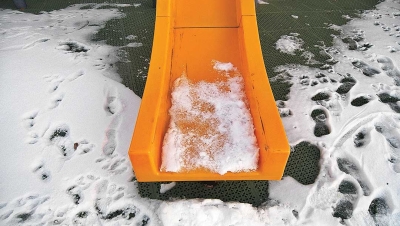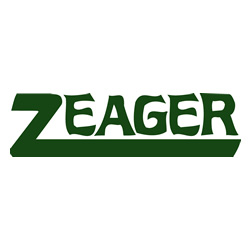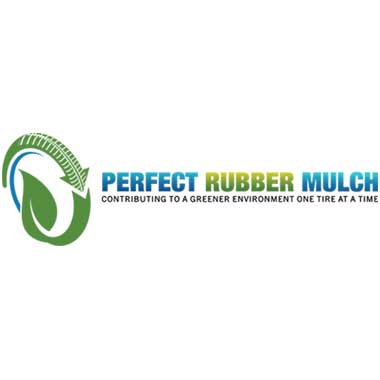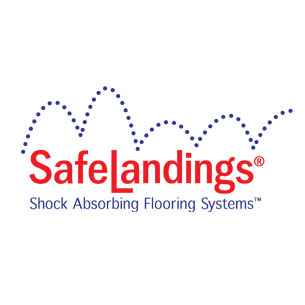Drop testing
If you are a playground owner, it is important you understand how squarely behind the 8 ball you are when it comes to standards. I apologize for all the technical details to follow, but it is important.
While traveling home after the May 7 and 8 Toronto ASTM Committee meetings, I started this column to try and capture my observations from all the meetings. One thing I observed was drop testing done by the F8.63 Subcommittee responsible for the ASTM F1292 Standard. There were 7 different Triaxs used to conduct a series of tests on the same test pad. This was a new pad made of a more dense materials that should result in a consistent and repeatable drop test result assuming all the Triax equipment was properly calibrated. The testing followed the ASTM F1292 field test protocol for consistency and relative accuracy to the real world. The premise of the test was to determine whether the test equipment has too large a variance in test results from one device to another or is the variance due to an inconsistent surfacing material used for conducting the laboratory test results versus the Triax field test results conducted on-site immediately after the same surfacing material has been installed. The results of the Toronto drop tests showed a 2% difference from the high to the low individual drop test results. This was based on 21 total drops on the same test pad. Bottom line is the differing values derived from field tests when compared to laboratory tests appear to be more related to how the installation of the surface system was done in the lab versus the actual on-site installation.
Which test results are more important to the owner of the playground? After a serious injury which result will the judge and jury consider most important? There are many variables that can impact test results in the field and that is troubling, since the owner has to maintain the system in compliance or remove it from use until it can be brought into compliance. What can we do about this from a standards based approach to assure compliance?
To put the remainder of my comments into perspective I will start with the following analogies to bring into perspective the current debate on injury prevention within the pubic play environment. We have heard many stories related to the successes of the automobile industry’s efforts to reduce death and severe injuries resulting from automobile accidents. Driving does not relate well to some when it comes to injury prevention in playgrounds and playground regulations. Nevertheless we do not remove our seatbelts or disconnect our airbag system just because we have not needed to use either. Today these passive safety features are in our cars because research demonstrated impact thresholds could consistently be reduced and thereby reduce the potential for the types of catastrophic injuries. So instead of the comparing the playground surfacing industry to the automobile industry, let me try this comparison on you.
I have been taking Statins for years as a preventive measure recommended by my Doctor to maintain my cholesterol at an acceptable level. This risk assessment was recommended by my Doctor since I had a history of heart related issues in my family. In spite of all the running and exercising I did in the 70s and 80s, my HDL and LDL numbers were elevated. Back then the recommended range for HDL and LDL levels were higher than what is recommended today. Even today the debate on what these numbers should be or whether or not these numbers are true markers for the likelihood of heart problems are still being challenged by some. Whatever was considered to be good or bad numbers 30 years ago are not close to what is being recommended today? I did not try to rationalize not to take my Doctor’s recommendation that I should modify my lifestyle and start taking his prescribed drug treatment. I could have argued that I was grandfathered in 10 or 15 years earlier when my numbers were only slightly high. I did have a choice, but I did not think it was a rational one. We usually listen to our Doctor since they are the experts. Most of us change our lifestyle habits based on research results and recommendations from people who know far more than we do when it comes to the medical profession. Everything seems to change when information presents a good reason to do so and the heart association raised everyone’s awareness of healthy living and using drugs like Statins to reduce and control cholesterol levels.
Just because your airbag has not been needed does not give reason to disconnect it or underestimate its value and to society as a whole who would not have to bear the cost of a lifetime of treatment should you become incapacitated. For the record my current HDL and LDL numbers are even within the new lower consensus numbers being recommended by the medical profession. I often wonder what might have happened if I had not taken my Doctor’s recommendation some 30 years ago? Let’s get to the subject related to public playgrounds.
For more than 40 years the U.S. Consumer Product Safety Commission (CPSC) and many other organizations have been gathering and analyzing playground injury data. Throughout this time, user impact with the surface has been the leading cause of playground injuries requiring medical attention and continues to be one of the four leading causes of death. This is not a new revelation. While the debate on whether the percentage of fall related injuries has increased or decreased, the fact remains falls and impact with the surface are still the number one cause of injuries requiring medical attention.
Since the beginning of the playground standards and guidelines development some 40 plus years ago, our industry has used the best research information available as the foundation of our final recommendations. When ASTM International (ASTM) F8.63 was given bythe CPSC a test method and minimum acceptable performance threshold to minimize the likelihood of life-threatening head injury, they took the recommendation from the CPSC for 200g and 1000 HIC. The rationale used to establish these first performance thresholds continues to be used by all international playground standards organizations. Unfortunately, there has been no measureable reduction in the number or severity of fall related injuries.
Both the F8.63 Subcommittee, responsible for the ASTM F1292 Standard, and the F15.29 Subcommittee, responsible for the ASTM F1487 Standard, continue to debate and discuss what the acceptable performance requirements should be within their respective documents. Who controls this debate? Who should control the outcome of the debate? The answer is easy. Thechildren impacting the surfaceshould control the outcome through the ASTM voting process but that is not how things are done. This ongoing debate may have a significant impact on the outcomes of the ASTM F1292 and F1487 Standards, but the few ASTM members who attend these meetings have the final say so. I would suggest that all Subcommittee members be allowed to vote electronically on whether or not negative votes are persuasive or not. This is a problem for the standard development process no matter which side of the vote an individual is on. Why should the deliberation of the few present at these meetings control the outcome? These meetings are rather expensive to attend when you factor in all the expenses with airfare, room, meals, and loss of income while at the meeting. I urge you to join ASTM and join these committees.
ASTM F15.29 is currently working on redefining its overall scope as it relates to the performance requirements. Our mission is to address known hazards that result in a level and frequency of injury identified in the ASTM F1487 Standard’s introduction and scoping statement. ASTM F15.29 has already addressed one form of impact hazard related to swings and other suspended components by reducing the impact threshold allowed in the surfacing impact attenuation standard 50% to maximum of 100g and 500 HIC. Since this revision applies to the performance of equipment, it falls under the purview of ASTM F15.29.
ASTM F08.63 Subcommittee, which by its scope is to provide both a test and minimum performance requirements, has had two attempts to reduce the impact threshold to 700 HIC, which would reduce Gmax to approximately 115 – 125, but both attempts have failed. The most recent ballot was to reduce the HIC to 700 for both preschool and school age user groups. While there were enough affirmative votes cast by the Subcommittee ballot to begin to address the few negative ballots, there was not the 2/3 affirmative vote cast at the recent meeting in Toronto to find the first negative vote non-persuasive. Therefore, the ballot item is stalled as the result of the affirmative vote outcome being less than the 2/3 majority vote requirement. There were approximately 30 people in attendance who actually voted, which is not an overwhelming number when you look at the total number of F8.63 Subcommittee voting members. The bottom line is the debate will continue, but who should have the final say so as to the impact thresholds?
The F1292 scope is to address a test method and threshold. The current threshold, from cadaver and primate studies in the automotive industry, has proven to be woefully inadequate. Thankfully there are not a large number of deaths when you look at the total number of injuries requiring medical attention. One thing everyone needs to understand is that while we have not reduced the current impact threshold in ASTM F1292, there is one requirement in that standard that significantly affects each owner of a public playground and the manufacturer of the equipment within that playground. F1292 states it is the owner/operator’s responsibility to maintain the surface in compliance throughout the life of the playground, and when tested in accordance with F1292, it is found to exceed the impact thresholds of 200g and/or 1000 HIC, it be taken out-of-service until it can be repaired and brought into compliance. The requirement to know this on the accessible route is part of the 2010 ADA standards, and F1487 requires that the surface be maintained to F1292.This can only be addressed with impact attenuation performance testing conducted in the field. Owners are sticking their heads in the sand, so to speak, if they do not already conduct this testing in the field to assure performance requirements, whether it is prior to first opening the play area or at some interval of performance field testing throughout the life of the playground. F08.63 Subcommittee members understand this. After all, they wrote it, but when something goes awry, who will be held accountable for less than acceptable impact attenuation performance?
The owner needs to understand that the existing and future revisions to all the standards within the purview of these two ASTM Subcommittees continue to hold the owner/operator responsible for attaining and maintaining the minimum requirements of these standards after installation or they have the responsibility to take the playground out-of-service until the equipment or surface are brought into compliance.
There appears to be some disconnect between the two ASTM Subcommittees which occurs immediately following a serious injury. When someone falls off a piece of playground equipment, the question becomes what caused the injury? Was it the equipment designer/manufacturer’s fault for creating too challenging a design or was there some design or manufacturing flaw in the product? Either one of these scenarios might bring the Consumer Product Safety Improvement Act (CPSIA) of 2008 into play.Potentially the owner is at fault for selecting the specific piece of equipment in the first place; however, maybe just maybe, it was a lack of adequate impact attenuating surface performance. Without a field testing compliance document there is no way to know for sure. I would like to suggest it might be the limiting capabilities of the current impact attenuation performance thresholds. It appears we have come full circle back to the age old question of “which came first, the chicken or the egg?” More important to these questions is who gets to answer these questions?
There is a general lack of knowledge by many owner/operators as to what these playground equipment and surfacing performance standards actually say? Do you know what these standards imply to each party involved in the management, design, layout, installation, inspection, maintenance, repair, and ultimately replacement of each and every public playground?
Those responsible for producing playground equipment and playground surfacing systems must be required to provide all information necessary to maintain the playground in compliance with all the standards that apply to public playgrounds if the playground owner/operator is ultimately the one that is accountable for the safety of the users.
This information is important to the owner/operator and designer, and it is needed in order to make an informed purchasing decision. These decisions should be based on the owner knowing how the surfacing and equipment is expected to perform and the requirements necessary to assure performance throughout the life of the playground and not just on cost. The owner needs much more than just the critical height of the surface system. The surface system manufacturer/installer must provide in writing all requirements and detailed instructions for proper installation, inspection, maintenance, and repair of the system throughout the reasonable projected life of the playground. Field performance, compliance testing, and some reasonable performance based, multi-year warranty to comply with performance standards must also be provided to the owner, if not required by the owner.
If the ASTM F1292 Standard can state in Section 4.4.2, “When an installed playground surface is tested in accordance with this section, if the impact test scores at any tested location in the use zone of a play structure do not meet the performance criterion, bring the surface into compliance with the requirements of this specification or the play structure shall not be permitted to be used until the playground surface complies,” then why should the ASTM F1487 Standard not be responsible for stating the who, how, what, and where requirements for surfacing compliance within this standard? There has been a long standing reluctance on the part of the F08.63 to make the field test a requirement for compliance to F1292. It is just an option available to the owner who must then follow the test method as described within the Standard. The reality of not performing compliance field testing does not say that the playground and/or surface cannot be used, just there is no written documentation for proof of compliance after installation as is required of the owner by the ASTM F1487 Standard.
The documents needed by the owner has to include information related to installation, safety performance, inspection frequency, routine and foreseeable maintenance requirements, and repairs required to keep the system in compliance with the various playground surfacing standards.
ASTM F1292 also states in Section 4.4.3:
“More Stringent Specifications—The specifier is permitted to specify additional impact attenuation performance requirements, providing that such additional performance requirements are more stringent than the performance requirements of this specification.”
ASTM F1487-11 Section 9 Play Structure Use Zone states:
“There shall be a use zone for each play structure which shall consist of obstacle-free surfacing that conforms to Specification F1292appropriate for the fall height of the equipment. The dimensions and configuration of the use zone shall be dependent upon the type of play equipment, as specified in Section 9. Use zones of certain types of equipment may overlap unless otherwise specified.”
ASTM F1487 Section 10.1 states:
“Playgrounds shall comply with the DOJ 2010 Standard for Accessible Design where applicable.”
This means firm, stable, slip resistant, and level within the requirements within the DOJ 2010 Standard.
ASTM F1487 Section 13 Maintenance states:
“13.2 Protective Surfacing:
13.2.1 The owner/operator shall maintain the protective surfacing within the use zone of each play structure in accordance with Specification F1292 appropriate for the fall height of each structure and Specification F1951 where applicable.
13.2.2 The owner/operator shall maintain the protective surfacing within the use zone of each play structure free from extraneous materials that could cause injury, infection, or disease.
13.3 Records—The owner/operator shall establish and maintain detailed installation, inspection, maintenance, and repair records for each public-use playground equipment area.”
CPSC Handbook states on page 8:
“Section 2.4 Surfacing - The surfacing under and around playground equipment is one of the most important factors in reducing the likelihood of life-threatening head injuries. A fall onto a shock absorbing surface is less likely to cause a serious head injury than a fall onto a hard surface. However, some injuries from falls, including broken limbs, may occur no matter what playground surfacing material is used.
The most widely used test method for evaluating the shock absorbing properties of a playground surfacing material is to drop an instrumented metal headform onto a sample of the material and record the acceleration/time pulse during the impact. Field and laboratory test methods are described in ASTM F1292 Standard Specification for Impact Attenuation of Surface Systems Under and Around Playground Equipment.
Testing using the methods described in ASTM F1292 will provide a ‘critical height’ rating of the surface. This height can be considered as an approximation of the fall height below which a life-threatening head injury would not be expected to occur. Manufacturers and installers of playground protective surfacing should provide the critical height rating of their materials.”
CPSC Handbook Section 4.1 Maintenance Inspections states:
“A comprehensive maintenance program should be developed for each playground. All playground areas and equipment should be inspected for excessive wear, deterioration, and any potential hazards, such as those shown in Table 3 (Specifically Problems with surfacing i.e. displaced loose-fill surfacing, holes, flakes, and/or buckling of unitary surfacing). One possible procedure is the use of checklists. Some manufacturers supply checklists for general or detailed inspections with their maintenance instructions. These can be used to ensure that inspections are in compliance with the manufacturerssurfacing specifications.”
Based on the above information and the lack of continuity and consistent intent of these documents there needs to be effort to clarify specific responsibilities of the playground owner and the supplier of the play components and impact attenuating surfacing required within the use zones of the play area.
My final thought is, if ASTM F1292-13 Standard Section 4.4.3 states, “More Stringent Specifications—The specifier is permitted to specify additional impact attenuation performance requirements, providing that such additional performance requirements are more stringent than the performance requirements of this specification,” then why should the specifier and/or owner, not be allowed to specify the performance threshold regardless of the recommended threshold in the ASTM F1292 Standard? More importantly, why should the ASTM F1487 Standard whose scope is to reduce all serious injuries be accountable for establishing an impact threshold that will address these injuries related to falls? The responsibility for establishing performance requirements for both surfacing within the use zones of public playgrounds as well as the playground equipment should be within the F1487 Standard’s scope as it relates to injury prevention.
The ASTM F08.63 Subcommittee must realize they have developed an extremely well scrutinized test and device that is used regularly in other ASTM Standards, such as wall padding and pole vault, and each have their own performance thresholds. This test device with its 4.6 kilogram hemispherical missile, or headform as we often refer to it, is migrating to the ASTM F355 test method and it may make ASTM F1292 less relevant. Many other ASTM Subcommittees related to sports surfacing and equipment have lowered or are considering lowering their Standard’s impact attenuation thresholds.
As a result of these actions, why should the F15.29 Subcommittee not undertake the responsibility for setting in the field playground surfacing performance thresholds for public playgrounds under the purview of F15.29, which is already responsible for establishing performance requirements for: materials used in the manufacturer of play structures, structural integrity loading requirements, equipment use zone requirements, specific equipment requirements and other requirements related to installation, maintenance, inspection, documentation, information and warning signs, and other hazards potentially found within the playground use zone?
This will become the next debate. What do you think?
Comments
1



















Add new comment